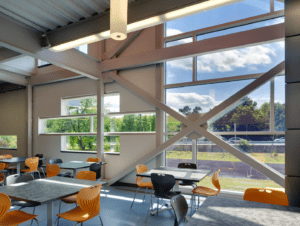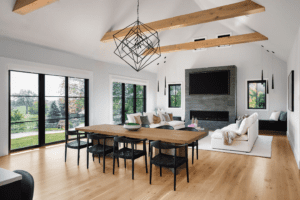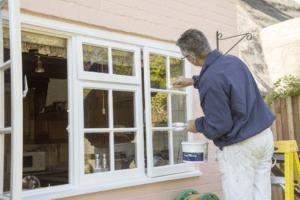(Consumer Reports) Big windows used to be associated with drafty homes and high energy bills. But innovations in today’s window and home construction have made it possible to install walls of windows that let in lots of natural light while keeping out the cold and noise.
Many of the windows on display at the International Builders’ Show are not only large but have black frames that blend seamlessly into the wall.
White Big Windows
“White window frames are traditional,” says Kris Hanson, a senior product manager at Marvin Windows and Doors. “Dark window frames are more modern—they allow you to see past the frame to what’s outside.”
Think of a movie theater in which the dark frame fades into the background calling your attention to the action on screen.
Dark frames, Hanson says, are all about paring down detail for a minimalist, streamlined aesthetic. With a darker frame, it’s more difficult to see different variations in the wood whereas a lighter frame may show off the wood grain.
Dark Windows
Dark window finishes are just part of a trend in home building that emphasizes the outdoors. Marvin Windows and Doors, Anderson Windows and Doors, and PGT Industries are all featuring automated floor-to-ceiling big windows system made of several panels of glass that glide open, blurring the distinction between windows and doors.
“Many consumers in coastal areas want big, open transitional indoor and outdoor spaces,” says Dean Ruark, director of product management at PGT. “They want large, automated windows that can open up like a door onto a back deck.” Ruark says that home building technology has advanced to such an extent that exterior walls can support windows made of moving panels more than 12 feet tall.
Smart Home Trend
And window makers haven’t overlooked the smart home trend. At Marvin Windows and Doors, Hanson displayed a prototype of its Lock Status Sensor in which sensors are integrated into the frames making it possible for homeowners to set up a smart home system that shows whether a window is unlocked, open, or closed and locked. If the homeowner isn’t ready to set up the system at first, it can be connected at a later date without further installation.
Another advance is in the glass itself. Some consumers are upgrading to wall-to-wall impact-resistant or laminated glass even if they don’t live in hurricane-prone areas, says Bryan Nicklas, “if you live in the center of the country, you might experience tornado or other severe storms with high winds,” he says. He adds that consumers also like impact-resistant windows because they reduce the noise from outside.







